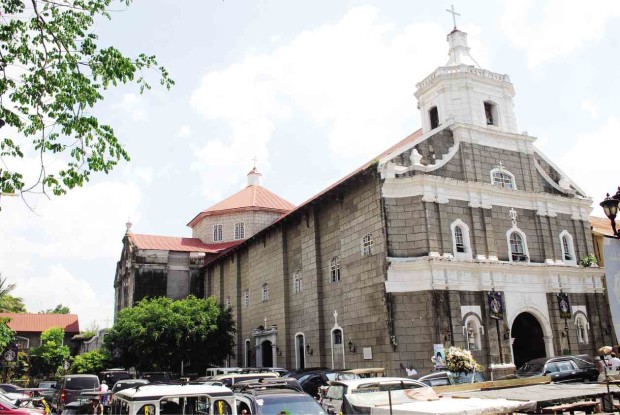Churches, places to visit in Ecija

THIS CHURCH in Gapan City, the oldest in Nueva Ecija province at 143 years, is the national shrine of La Virgen Divina Pastora. It draws thousands of pilgrims, as well as the city’s devotees, as many miracles and answered petitions are attributed to the image. ANSELMO ROQUE/INQUIRER CENTRAL LUZON
CABANATUAN CITY—People may spend their Holy Week break visiting churches or places that may help strengthen their faith, and Nueva Ecija province is the destination for these pilgrimages.
The church in Nampicuan town in western Nueva Ecija is ideal for a pilgrimage as it is the sanctuary of the “Holy Face of Jesus.”
A “first degree replica” of the original image, which is being kept in the basilica in Manoppello in Pescara, Italy, is enshrined in this church. The image is one of two replicas in the world. The other is in the Manoppello basilica itself and is used for public viewing and veneration.
“By first degree replica, it means that some elements of the original image could be found in the image at Nampicuan church,” said Fr. Christian Magtalas, the town’s parish priest.
The original image, called “Sudarium,” is a cloth made of precious marine silk measuring 17 centimeters (6.70 inches) by 24 centimeters (9.45 inches). It bears an imprint of an effigy, Magtalas said, citing accounts about the Holy Face.
Article continues after this advertisementThe effigy resembles “a long-haired man with a broken nose, bloodstained forehead, swollen cheek, half-opened mouth, dark brows covering his face, and eyes in an irregular way, completely open,” he said.
Article continues after this advertisementJesus’ tomb
Quoting from the church’s official account, Magtalas said the Sudarium came from the place where Jesus was entombed. It was lost in a raid on Rome in 846 AD, when attackers took rich liturgical vessels and reliquaries housing relics from the basilicas of St. Peter and St. Paul.
The relic was transferred from one country to another and was handed by a stranger to a doctor in 1506 in the mountain village of Manoppello.
The doctor kept the relic for almost a century, but it was stolen and sold by his son-in-law to another doctor who eventually turned it over to the Capuchin monks in that town. The monks remain the official caretakers of the relic to this day. It is kept in a secret place by the monks and only a replica is publicly displayed.
In 2014, one of the two replicas was brought by the rector of the basilica in Manoppello to the Philippines for display and veneration in different churches in Metro Manila and some other places.
On its last leg, the replica of the Sudarium was brought to Nampicuan and was allowed to be stored permanently in the town’s church.
Prayers for replica
“Our Catholic faithful here in Nampicuan stormed heaven with a recitation of 4,000 ‘Hail Mary’ prayers as we appealed to the Manoppello church authorities to allow the stay of the replica here permanently,” Magtalas said.
On Sept. 16, 2014, officials of the Diocese of San Jose, City of San Fernando, Pampanga province, and of Tarlac province, and the rector of the Manoppello basilica enshrined the replica in the Nampicuan church.
Nampicuan can be reached by a 10-minute drive from the Anao, Tarlac tollway of the Tarlac-Pangasinan-La Union Expressway (TPLEx).
Another church to visit is in Gapan City, 96 kilometers north of Manila via the Maharlika Highway, where the wooden image of La Virgen Divina Pastora, or the Divine Shepherdess, attracts wide attention.
The image was crowned more than half a century ago. Years later, the church was declared the national shrine of La Virgen Divina Pastora.
Miracles
Parishioners in Gapan and those from other places have attributed several miracles and answered prayers to the image.
Other shrines to visit in Nueva Ecija are the diocesan shrine of St. John the Baptist in Bibiclat in Aliaga town and the diocesan shrine of San Geronimo in Baloc in Santo Domingo town.
In Bibiclat, devotees transform themselves into “mud people” every June 24 to simulate the beggarly attire of St. John the Baptist, as described in the biblical myth, to prepare the way for the coming of Jesus.
Many miracles have been attributed to this image, which was brought to the village by settlers from the Ilocos region. A popular tale involves the male residents of the village who were lined up for execution by Japanese soldiers in retaliation for the death of 13 soldiers.
The women prayed hard to the image to save the condemned men and a heavy rain sent the soldiers inside the church. It was said that the soldiers’ hearts softened and they abandoned the execution.
Diocesan shrine
The church in Baloc has been declared a diocesan shrine of St. Jerome (San Geronimo). Described as the greatest of all church doctors who translated the books of the Old Testament from Hebrew to Latin, San Geronimo is venerated by many devotees who attributed to him numerous answers to their petitions.
Another image of the saint is also enshrined in the Aglipayan church, a hundred meters away from the Catholic church. Both churches observe the feast day of San Geronimo on Sept. 30.
In Barangay Olivete in Bongabon town, people may join other pilgrims in visiting the church of the religious sect Sambahan ng Amang Kaama-amahan at Inang Kaina-inahan (SNAK-IK).
The sect’s shrine has a chapel on a hill in whose altar a painting of an “eye,” which believers say represents the “all-seeing God who watches over us,” is installed.
People visiting the place enter the caves whose interior walls have become smooth as a result of continuous rubbing of handkerchiefs or pieces of cloth for divine healing. They also wade through a winding creek up to a waterfall and to the pool below. Many believe that the water from the spring, called Jordan, has healing powers.
On Good Friday, sect members walk barefoot on a 2.3-kilometer dirt road in the village for their annual procession.